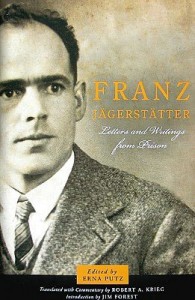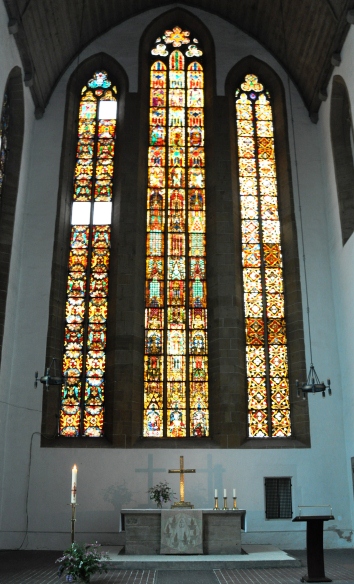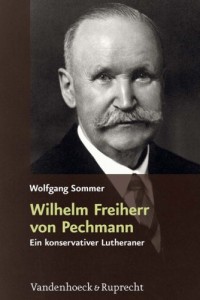ACCH Quarterly Vol. 17, No. 2, June 2011
Review of Erna Putz, ed., Franz Jaegerstaetter: Letters and Writings from Prison, trans. Robert Anthony Krieg (Maryknoll: Orbis Books, 2009), 252 Pp. ISBN 978-1-57075-826-3.
By Beth A. Griech-Polelle, Bowling Green State University
This review appeared first in H-German, H-Net Reviews in February 2011 (URL: http://www.h-net.org/reviews/showrev.php?id=31488) and is reprinted by kind permission of the author.
 This volume presents the life and thoughts of a once obscure Austrian farmer, Franz Jaegerstaetter (1907-43). Thanks in part to the research of Gordon Zahn in the 1960s, Jaegerstaetter’s name began to circulate as a conscientious objector to Hitler’s brutal war.[1] And now, thanks to the beautiful translations of Robert Krieg and the careful editing of Erna Putz, readers can be reintroduced to the deeply moving writings of a truly spiritual man who determined that it would be better to die for his Catholic faith than to serve the evils of National Socialism.
This volume presents the life and thoughts of a once obscure Austrian farmer, Franz Jaegerstaetter (1907-43). Thanks in part to the research of Gordon Zahn in the 1960s, Jaegerstaetter’s name began to circulate as a conscientious objector to Hitler’s brutal war.[1] And now, thanks to the beautiful translations of Robert Krieg and the careful editing of Erna Putz, readers can be reintroduced to the deeply moving writings of a truly spiritual man who determined that it would be better to die for his Catholic faith than to serve the evils of National Socialism.
The collection begins with Jim Forest’s introduction and with Robert Krieg’s overview of the general outline of Franz Jaegerstaetter’s life and death. Readers are transported to the small village of St. Radegund (d. 587) in Austria, not far from Adolf Hitler’s birthplace, Braunau-am-Inn. It is perhaps fitting that Jaegerstaetter was born in St. Radegund, since Radegund had lived through political turmoil, family assassinations, a forced marriage, and finally the formation of her own convent. St. Radegund’s institution enforced strict rules of meditation and constant prayer, and this example might have been useful to Jaegerstaetter, although his early life showed no signs of potential sainthood or a calling to martyrdom. Born an illegitimate child, Franz was eventually adopted by his mother’s husband. He had only an eighth-grade education, got in fist-fights, fathered an illegitimate daughter himself, and rode around on the village’s only motorcycle. Jaegerstaetter’s life, however, took a more noticeable turn when he married the devout Franziska Schwaninger. The farming neighbors may never have known this, but prior to Franz and Franziska’s marriage, both of them had independently considered entering religious life. However, most neighbors thought that Franz’s new wife influenced his openly religious dedication.
Part 1 of the volume reveals the extent to which Franz and Franziska’s religious views overlapped and supported each another. Here, Putz provides correspondence between the husband and wife while Franz was completing required military training (1940 and 1941), and then later his letters from his imprisonment (March-August, 1943). Throughout the correspondence, the couple’s love and respect for each other is evident. During the military training period, most of the letters detail the everyday life on the farm for Franziska, Franz’s widowed mother, and the couple’s three daughters. These letters have at times a playful note, since the couple fully anticipated being reunited once the training period was over. Franz offers advice about running the farm, often urging Franziska not to work too hard and to leave things for him to do upon his return. He also wrote briefly to Franziska’s father, who often came to help at the Jaegerstaetter’s farm. At other times, Franz begins to allude to his trouble in accepting the membership requirements of the “Volk community.” As his military training progresses, Franz begins to express more of his frustration with what he refers to as “the stream,” that is, National Socialism. He constantly uses this metaphor of struggling against “the stream’s” strong current, and he expresses dismay at the futility of much of what the training has entailed.
Although all of these letters offer compelling reading regarding the state of mind of Franz and Franziska, they also offer historians insight into the everyday life of Catholic farming communities under National Socialism. In them we see how various local priests were denounced, arrested, and imprisoned for speaking openly against the policies of the Third Reich. We run across Franz mentioning a mental institution in Ybb, and he alludes to the murderous “euthanasia project” of the Nazis. In some of Franziska’s letters from home, we can see how children were not allowed to attend mass on school days, how feast days had to be moved so Catholics could attend mass, how local politics played a role in who received leaves of absence, and who got to run an inn and whose inn was shut down due to “political unreliability.” Throughout this entire period, Franziska experiences pressure to participate in the local Nazi organizations, such as the Women’s Association, including the threat of social ostracism when choosing to opt out in this very small community.
The situation changes dramatically for the Jaegerstaetters on February 22, 1943. Franz receives notification that he is required to go to Enns for military service on February 25, 1943. By this time, Franz had written essays in various notebooks at home, which helped him to decide to refuse to fight for the Reich. Arriving at the Enns’ induction center on March 1, 1943, Franz had to return the next day due to a long line of men ahead of him. On March 2, 1943 Franz declared himself unwilling to fight for National Socialism, and, as he had anticipated, he was immediately arrested. Chapter 4 contains the correspondence between Franz and Franziska (although there was censorship of the mail) while Franz was in the prison in Linz. At this point of Franz’s incarceration, he still remained hopeful that he would be able to live, writing, “I want to save my life but not through lies” (p. 82). Indeed Franz writes to his wife that he would be willing to serve as a military medic, as that would not contradict his Christian conscience (p. 86). Ultimately, Franz decides that he cannot serve in any capacity in the military because he would be required to take the military oath of unconditional obedience to the Führer. What also emerges in this section is Franz working through his position, struggling with commands to obey earthly authority while serving the will of God. He resolves that it is far better to obey God than men. Jaegerstaetter determined that his eternal salvation was more important to him than his physical well-being, or even life. At the moment of his transfer to Berlin’s Tegel Prison, he quickly writes to Franziska, “Concerning my decision, I can tell you that I have come to no different decision as a result of the process that has played itself out. I am resolved to act no differently” (p. 108).
Arriving in Berlin on May 4, 1943, Franz was immediately incarcerated in the Tegel prison where he awaited his trial and sentence. At this point, Franz was only permitted to write one letter per month to his wife, but Franziska was allowed to send at least twelve letters to her husband. She was also able to visit him for twenty minutes on July 13. In Franz’s letters, he constantly offers his wife consolation, telling her that he is eating well, and is not physically suffering. He nonetheless exhorts her to continue to pray for him. Franziska sends him prayers, Communion petitions, and updates on village and farm activities. At one point, she is even able to send him a photograph of their lovely young daughters, which surely broke his heart. No less emotionally daunting for Franz would be the surprise visit of Franziska and Pastor Fürthauer on July 13, 1943. Franz’s defense attorney had arranged the meeting, urging Franziska and the priest to convince Franz to sign a statement that he would be willing to serve in the military. The twenty-minute meeting did not go smoothly. Franz became agitated with the priest, and in the days leading up to Franz’s execution, he wrote his last letters to Franziska, asking her, “Do you believe that all would go well for me if I were to lie in order to prolong my life?” (p. 128).
Franz, his hands in chains, wrote, “Do not be overly concerned about earthly things. The Lord indeed knows what we need…. In the next life we need suffer no longer. And the greater the suffering here, the greater the joy there” (p. 128). This letter was mailed the morning of August 9, the day that Franz was transferred to the prison at Brandenburg. There he wrote a final letter to his family, asking them for their forgiveness if he had offended them. At 4 p.m., August 9, 1943, Franz was guillotined. The priest, Pastor Albert Jochmann, reported that Franz went to his death peacefully.
Part 2 of the collection shows the evolution of Franz’s religious and political thought. There are two poems he wrote in 1932, and then a longer letter that he had written to his godson in 1935. The first of the notebooks was written by Franz in the period between his military training and his imprisonment. Each of the essays describes Franz’s thoughts on various aspects of Christian life, ranging from “On Faith” to “On our Fear of Other People” to “A Brief Reflection on the Current Era.” He addressed all of the essays to his family. They reveal Franz’s deep concern to preserve his integrity despite pressure from many sides to superficially accept the Nazi regime. He refused, stating, “What a terror it would be for us if we were sentenced by an earthly judge to life in prison. Yet it would be an even greater terror if we were sentenced by the eternal Judge to eternal damnation” (p. 158). The final essay in this notebook again directly references the dangers of swimming along with seemingly everyone else in “the stream,” and the dangers to one’s eternal soul.
Notebook 2, written in 1942, addresses the demands of National Socialism, opening with the important question: “Can someone be both a Catholic and a National Socialist?” (p. 173), to which Jaegerstaetter answers no. Catholics need to pull themselves “out of this swamp in which we are stuck and to become eternally blessed” (p. 176). He argues that suffering and martyrdom are part of working for Christ and one way to earn a place in Heaven. In subsequent essays, Franz explains that it will take true courage to be able to separate oneself from the “anti-Christian Volk community” (p. 178), but the promise of eternal salvation far outweighs any earthly suffering one might endure. He also argues that an acceptance of Nazism based on its fight against atheistic Bolshevism does not justify the taking of lives and property of Russian people (p. 183). He criticizes the lack of guidance and instruction from Catholic Church leaders: “Finding the right path is especially difficult when those who know about this path refuse to answer questions or give false information” (p.187). He then writes that Pope Pius XI warned that National Socialism was, in fact, more dangerous than communism (p. 190).
Chapters 9 through 12 contain separate essays and shorter notebooks, in which Franz continues his exploration of his faith and his understanding of the world and its demands. Throughout these writings, Franz argues that people must move beyond being Catholic in words but not in action. He refuses to judge National Socialists or people who claim to be Nazis, but he states that he does judge National Socialism as an evil ideology that endangers people’s souls. He asks, “Is death so horrible for us Catholics that we must gladly do everything so that we can lengthen our lives? Must we experience all of life’s enjoyments? Would we find much in this world to be difficult if we were to keep in mind the eternal joy of Heaven?” (p. 203). Throughout his final writings, Franz insists that Catholics take action in order to save themselves: “Who fares better in this world: the person who places earthly life before eternal life or the person who puts eternal life before earthly life?… For instead of being concerned about saving me from serious sins and directing me toward eternal life, these people are concerned about rescuing me from an earthly death” (p. 243). What Franz Jaegerstaetter concluded was startingly simple: “People want to observe Christians who have taken a stand in the contemporary world, Christians who live amid all of the darkness with clarity, insight, and conviction” (p. 211). He decided to live and to die with that clarity and conviction.
This deeply moving book is more than a collection of letters and essays by an uncompromising individual. It poses universal questions about the moral and physical consequences of the decisions that people make every day–questions about obedience to different institutions and individuals, and whether one should accept the cost of remaining quiet and going along with situations that give us ethical misgivings. Readers will be challenged and even inspired by the clear-sightedness of one obscure, straight-talking Austrian farmer, who decided that his “No,” even if it brought him an earthly death, was worth eternal life.
Note
[1]. Gordon Charles Zahn, In Solitary Witness: The Life and Death of Franz Jaegerstaetter, revised ed. (Spingfield, IL: Tempelgate,1986).



